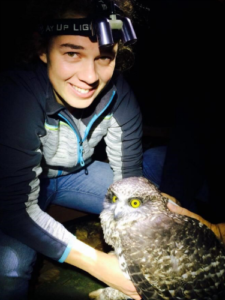Menai Group’s April speaker was Lisa Harvey speaking on her Honours project – to fit tracking collars to Powerful Owls to enable research into habitat in urban Sydney.

The Powerful Owl is Australia’s largest apex nocturnal predator owl, it is present along the Eastern Coast and is listed as vulnerable in NSW.
The owl is a territorial obligate hollow nester, 60cm in height with a wingspan of 140cm, it is estimated Sydney has 50-60 pairs with approximately 10-12 additional single birds.
The Powerful Owl Project was initiated by Birdlife Australia in 2011. This project is a citizen science project investigating breeding success, habitat use and diet of Powerful Owls in Sydney and the Central Coast. Lisa’s research extended this project to find more information about habitat use and diet and to compare home range sizes of the Powerful Owl in areas of varying degrees of urbanisation across Sydney.
To succeed, GPS transmitters with a weak link harness designed to fall off after a number of weeks were attached to 3 females & 2 males. Suitable trees with reasonably clear surrounding foliage had to be located to enable the slinging of a net, raised with the aid of a bow and arrow, to trap an owl responding to the call of a female, male or even a young owl.
The owls were fitted with transmitters and tracked during the breeding season throughout the Sydney region. The GPS GSM transmitters enabled remote access to data via the mobile phone network. GPS fixes were first recorded ½ hourly then switched to hourly throughout the tracking period. Lisa showed the results of the main areas tracked, multiple home range trips with the owls in Balgowlah Heights, Bonnet Bay, Menai, Centennial Park and the Botanic Gardens.
The availability of vegetation may affect home range size, the variations found were: Botanic Gardens approx. 650ha, Centennial Park approx. 300ha, Bonnet Bay approx. 220ha, Balgowlah Heights approx. 110ha, Menai approx. 20ha.
Greenspace is an important element to habitat. Different types of greenspaces were used such as structured gardens in the Royal Botanic Gardens and natural bushland in the Sydney Harbour National Park at Balgowlah. Overall 85% of GPS locations were recorded in greenspace, dwelling density within an owl’s home range varied between 0.43 & 6.26 km2. Balgowlah had approx. 80% greenspace, Bonnet Bay approx. 60%, Botanic Gardens approx. 90%, Centennial Park approx. 95% and Menai approx. 99%.
Collection and dissection of owl regurgitate assisted in determining the diet consumed by the tracked owls and also other known pairs throughout Sydney. Of the 74 pellets analysed, prey items were identified from bone fragments, hair and feathers.
The GPS results in the Sydney region showed the common ringtail possum rating approx. 35% on the scale, the flying fox approx. 15%, rats approx. 15%, birds approx. 14%, common brush tail possum approx. 10%, sugar gliders approx. 3%, rabbits approx. 3% and unknown mammalians approx. 3%.

What is the future for urban Powerful Owls? Prey is unlikely to be a limiting factor due to the abundance of key prey items such as the Common Ringtail Possum and Common Brushtail Possum. Habitat loss, especially the loss of old trees capable of producing large hollows for breeding is likely to be a significant concern. Other issues include human-wildlife conflict, with the Powerful Owl being susceptible to car strike and collisions with buildings. In highly urbanised areas, the owls may have to fly further afield to find greenspace and because of the risks associated with urban areas, greenspace design in cities could help reduce this risk.
Future projects will entail research into hollow availability and characteristics of greenspaces.
The dedicated teams tracking, monitoring, researching and sharing their findings on these magnificent owls is greatly appreciated by all – we thank Lisa, Birdlife Australia, The University of Sydney, The City of Sydney and the Royal Botanic Gardens for their generosity.
